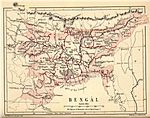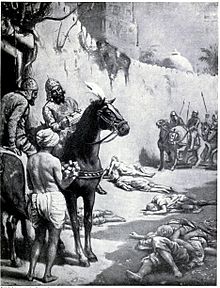Muhammad Bakhtiyar Khalji
Ikhtiyar al-Din Muhammad bin Bakhtiyar Khilji | |
|---|---|
| Died | 1206 |
| Occupation | Military General |
| History of Bengal |
|---|
 |
Ikhtiyar al-Din Muhammad bin Bakhtiyar Khilji,[1] also known as Malik Ghazi Ikhtiyar 'l-Din Muhammad Bakhtiyar Khilji or Muhammad Bakhtiyar Khilji or simply Bakhtiyar Khilji (died 1206), was a Turkic[2] military general of Qutb al-Din Aibak.
Early life
Bakhtiyar Khilji, a member of the Khilji tribe,[2] a Turkic tribe long settled in what is now southern Afghanistan,[3] was head of the military force that conquered much of eastern India at the end of the 12th Century and at the beginning of the 13th century.[4]
Rise
Khilji came from the town of Garmsir in present-day southern Afghanistan. Tradition has it that Khilji's conquest of Bengal at the head of 18 horsemen was foretold.[5] It is reported that he was of common birth,[6] had long arms extending below his knees,[5] a short physical stature, and an unfavorable countenance. He was first appointed as the Dewan-i-Ard at Ghor. Then he approached India in about the year 1193 and tried to enter in the army of Qutb-al-Din, but was refused rank. Then he went further eastward and took a job under Maklik Hizbar al-Din, then in command of a platoon at Badayun in northern India.[6] After a short period he went to Oudh where Malik Husam al-Din, recognized him for his worth.[6] Husam gave him a landed estate in the south-eastern corner of modern Mirzapur district. Khilji soon consolidated his position by recruiting some fiercely Muslim soldiers under his domain and carried out successful raids into neighboring regions.[4]
Conquests

A certain reference in literature suggests that in 1193, the ancient college-city of Nalanda and the university of Vikramshila were sacked by[7] Bakhtiyar Khilji.[8]

Khilji's career took a new turn when he subjugated Bihar in 1203.[4] This effort earned him political clout in the court at Delhi. In the same year he took his forces into Bengal. As he came upon the city of Nabadwip, it is said that he advanced so rapidly that only 18 horsemen from his army could keep up. He conquered Nabadwip from the old emperor Lakshman Sen in 1203.[9] Subsequently Khilji went on to capture the capital and the principal city, Gaur,[4] and intruded into much of Bengal.[10][11]
Death and aftermath
Ikhtiyar Khilji left the town of Devkot in 1206 to attack Tibet, leaving Ali Mardan Khilji in Ghoraghat Upazila to watch the eastern frontier from his headquarters at Barisal. Khilji forces were ambushed in Assam and Ikhtiyar returned to Devkot with about one hundred surviving soldier. Upon Ikhtiyar Khilji's return to India, while he was lying ill at Devkot, he was assassinated by Ali Mardan.[12]
Loyal troops under Muhammad Shiran Khilji avenged Ikhtiyar's death, imprisoning Ali Mardan. Ghiyas-ud-din Iwaz Khilji became the successor. Ali Mardan escaped and was made Governor of Bengal by Qutb-ud-din Aibak, but was killed in 1210. Ghiyas-ud-din again assumed power and proclaimed his independence.[12]
Legacy
Al Mahmud, a leading Bangladeshi poet, composed a book of poetry titled Bakhtiyarer Ghora (Horses of Bakhtiyar) in the early 1990s.[13] He depicted Khilji as the praiseworthy figurehead of conquest of Bengal. During Bakhtiyar Khilji's reign, Islam gained a large number of converts in India.[14] Muhammad Bakhtiyar Khilji had the Khutbah read and coins struck in his own name. Mosques, madrasas, and khanqahs arose in the new abode of Islam through Bakhtiyar's patronage, and his example was imitated by his Amirs.
Buddhist sources hold him responsible for the destruction of Nalanda.[15][16]
See also
- List of rulers of Bengal
- Sultan Mahmud Ghaznavi
- Ghazi Saiyyad Salar Masud
- Khilji dynasty
- Bakhtiarpur
- Nalanda
References
- ^ Britannica
- ^ a b The Turkish Khilji must not be confused with the Pastun Ghalzi tribe. Minhāju-s Sirāj (1881). Tabaḳāt-i-nāsiri: a general history of the Muhammadan dynastics of Asia, including Hindustān, from A.H. 194 (810 A.D.) to A.H. 658 (1260 A.D.) and the irruption of the infidel Mughals into Islām. Bibliotheca Indica #78. Vol. 1. Calcutta, India: Royal Asiatic Society of Bengal (printed by Gilbert & Rivington). p. 548. (translated from the Persian by Henry George Raverty)
- ^ the Khiljī tribe had long been settled in what is now Afghanistan ... Khalji Dynasty. Encyclopædia Britannica. 2010. Encyclopædia Britannica Online. 23 August 2010.
- ^ a b c d Sarkar, Jadunath (2003). The History of Bengal (Volume II): Muslim Period. Delhi: B.R. Publishing. ISBN 81-7646-239-X.
{{cite book}}: Cite has empty unknown parameter:|coauthors=(help) - ^ a b (Minhāju-s Sirāj 1881:556–557)
- ^ a b c (Minhāju-s Sirāj 1881:549)
- ^ "The Buddha and the Sahibs" by Charles Allen
- ^ Scott, David (May 1995). "Buddhism and Islam: Past to Present Encounters and Interfaith Lessons". Numen. 42 (2): 141. doi:10.1163/1568527952598657.
- ^ "District Website of Nadia". Government of West Bengal.Retrieved: 2014-01-11
- ^ Sen, Amulyachandra (1954). Rajagriha and Nalanda. Institute of Indology, volume 4. Calcutta: Calcutta Institute of Indology, Indian Publicity Society. p. 52. OCLC 28533779.
- ^ "Far East Kingdoms".
- ^ a b Chandra, Satish (2004), Medieval India: From Sultanat to the Mughals-Delhi Sultanat (1206-1526) - Part One, Har-Anand Publications, pp. 41–43
- ^ "Al Mahmud". Truly Bangladesh.Retrieved: 2014-01-22
- ^ The Preaching of Islam: A History of the Propagation of the Muslim Faith, by Sir Thomas Walker Arnold, pg. 227–228
- ^ Shōhei Ichimura, Buddhist Critical Spirituality: Prajñā and Śūnyatā, (Motilal Banarsidass, 2001), 65 n87.
- ^ Sen, Gertrude Emerson. The Story of Early Indian Civilization. Orient Longmans.
External links
- Sir Jadunath Sarkar, History of Bengal, II (Dhaka, 1948)
- History of the Muslims of Bengal - Volume 1A: Muslim Rule in Bengal (600-170/1203-1757), by Muhammad Mohar Ali, Imam Muhammad ibn Saud Islamic University, Department of Culture and Publications.
- Bakhtiyar Khalji, Banglapedia
- Sena Dynasty, Banglapedia
